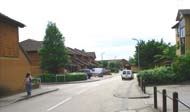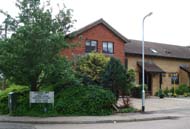(Holywell Wing)
Infectious diseases
The Watford and District Isolation Hospital was officially opened by Lady Essex on 24th March 1896. It was built on a 4-acre plot of land in Tolpits Lane which had been donated by the Earl of Essex. The building work had taken 17 months to complete, at a cost of about £12,000.
The administration block contained a doctor's office, a dispensary and a kitchen, as well as accommodation for the nurses - bedrooms, a dining room and a sitting room. A telephone system had been installed.
The Hospital had 42 beds, located in 10 wards within four blocks. Open stoves in the middle of the wards and fireplaces provided heating. The flooring consisted of oak blocks set in concrete. Vents in the roof and air inlets set in the wall below bed height provided additional ventilation to the windows.
The site also contained a Porter's Lodge, two discharge blocks, a disinfection station and a laundry, a mortuary, and a stable for the ambulance horse.
A kitchen garden provided vegetables for the Hospital, while a poultry run supplied eggs and meat.
The first patients were admitted on 4th April 1896. The Hospital dealt mainly with those who had smallpox, scarlet fever, diphtheria, enteric fever, erysipelas and other infectious diseases. One year after opening, private patients from outside the area were also admitted.
In 1902, during an outbreak of scarlet fever, the Hospital had no available beds and many patients were forced to remain at home, leading to more cases within family groups. A number of tents were then purchased by the Hospital to provide 20 extra beds.
It was recognised that the Hospital needed to be modernised and enlarged and this work was carried out in 1904. All the buildings were connected to the main sewer. Electric lighting had been installed for all the wards, and each bed had its own lamp and wall socket. The heating system was improved. The Hospital then had 66 beds.It was further extended again in 1934, at a cost of £26,000, and had 100 beds.
During WW2 the Hospital was used to accommodate Canadian soldiers with diphtheria.
It joined the NHS in 1948 as a TB hospital, and was renamed the Holywell Hospital. By 1950 it had 110 beds.
It merged with Watford General Hospital in 1968 and became its Holywell Wing.
In 1972 it became a geriatric hospital.
It closed in 1982 and services were transferred to the Watford General Hospital.
Present status (June 2008)

Looking along Chenies Way from the east entrance of the estate off Tolpits Lane

Housing along Chenies Way

The south entrance to the estate at the corner of Tolpits Lane and Chenies Way
http://apps.nationalarchives.gov.uk
http://edithsstreets.blogspot.co.uk
www.british-history.ac.uk
www.myjustamoment.com
www.watfordobserver.co.uk
www.westwatfordhistorygroup.org (1)
www.westwatfordhistorygroup.org (2)
Return to home page